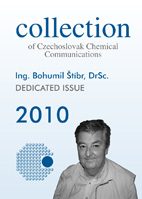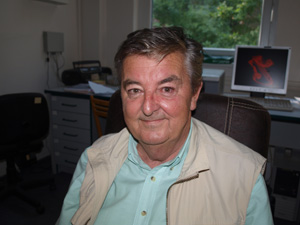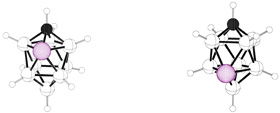
- ISSN 0010-0765 printed
- ISSN 1212-6950 electronic

Ing. Bohumil Štíbr, DrSc. 70th Birthday - Foreword

Bob Štíbr, who celebrates his 70th birthady this summer, is one of the founders of the unique Czech school of boron chemistry, established in the former Czechoslovakia at the beginning of the 1960's. He does not need too much introduction, being known to every borane chemist in the world and also well-recognized and highly-considered amongst Czech inorganic chemists generally. Whilst officially retired, he is still very active at the Institute of Inorganic Chemistry of the Academy of Science of the Czech Republic, sitting in his office and walking through his laboratory, where he makes a lot of effort to finish all the arrears of work that deserve to be published. It is always a pleasure talking with him; his replies full of sense of humour and seeds of new ideas to all of us. Often he has a pensive and contiplative mood; silently smoking and thinking about what other matters of boron chemistry should be addressed. I am pretty sure that a lot of his brilliant ideas ocurred to him when sitting on the bank of a river during his his favorite leisure activity - fishing. He is very keen fisherman and an excellent cook of the carp that he catches. More than 20 years have passed since I first met Bob. He very quickly became interested in the research area that I wanted to introduce into this world-wide known boron chemistry research group - molecular structure determination of the boron clusters in the gas phase by electron diffraction as well as by employing computational methods. His interest in such a joint experimental/computational strategy in this kind of research still persits.
Professor Bohumil Štíbr was born on July 17th, 1940 in Slaný, the 'Town of Hops', as he says with his typical sense of humour. He graduated in Inorganic Chemistry at the University of Pardubice in 1962, where he also pursued his PhD (= CSc.), finished in 1968 with a first-class degree award. Simultaneous to his studies, he was also very active in the area of boron cluster chemistry at Řež. He has been employed at the Institute of Inorganic Chemistry (IIC) at Řež since then, currently as a senior research fellow. He has been in charge of the IIC's boron group for 25 years. In 1997 he defended his DrSc thesis. Dr. Štíbr also enjoyed several working visits to various internaional research centres. In 1972 he worked with Profesor M. F. Hawthorne at the University of California in Los Angeles as a postdoctoral research fellow. During his chairmanship of the international conference IMEBORON VI held at Bechyně, Czechoslovakia, in 1987, he established, together with Profesor J. D. Kennedy (University of Leeds), the so-called ACPC (Anglo-Czech-Polyhedral-Collaboration, sometimes alternatively referred to in jest as the Anglo-Czech-Pivo (=Beer) - Club). The ACPC became a very productive international collaboration, further strengthened by his visiting the University of Leeds in 1989, where he worked with Kennedy as a Royal Society Fellow. The ACPC, highly-regarded both by the Academy of Sciences of the Czech Republic and the Royal Society, has been evaluated as one of the most fruitful scientific cooperations sponsored both by the Academy of Sciences of the Czech Republic and the Royal Society (reflected in the publishing of more than 100 papers in top ranking chemical journals). During the years 1995-1997 Štíbr was a visiting professor at the Institute of Material Chemistry in Barcelona, working with Professor F. Teixidor. Bob's scientific endeavour was also recognized by the Alexander von Humboldt Foundation that awarded him a fellowship in 2001, a year which he spent with Professor B. Wrackmeyer at the University of Bayreuth in Germany.
It would be like carrying coals to Newcastle to enumerate all of Bob's achievements in the area of boron cluster chemistry. I shall thus attempt to simply outline the most important milestones of his work here. Perhaps firstly, and arguably most importantly, he is responsible for the discovery of a whole series of parent monocarbaboranes and dicarbaboranes that include [2-CB6H7]-, 2-CB6H8, [2-CB7H8]-, [4-CB8H9]-, 1-CB8H12, 4-CB8H14, [5-CB8H13]-, [6-CB9H12]-,[6-CB9H14]- and [4,5-C2B6H11]-, [6,9-C2B8H10]2-, 6,9-C2B8H14. The latter compound is known amongst his colleagues as "Štíbroxid" using Řež jargon. The corresponding metallacarbaborane chemistries of these parent componds have also been developed by Bob and his co-workers. Not satisfied with only one or two carbons inserted into a borane cluster, Bob continued with his efforts to introduce more carbons to boron frameworks. Indeed he opened the area of the parent tricarbaboranes such as 5,6,9-C3B7H11, 7,8,9-C3B8H12, [7,8,9-C3B8H11]- and [7,8,10-C3B8H11]- along with the chemistry of ferratricarbolides. Continuing yet further, he was later successful in isolating tetracarbaboranes, 5,6,9,10-C4B6H10 and two isomers of C4B7H11, and even a hexacarbaborane represented by C6B8H14. Bob has also prepared many heteroboranes that contain other main-group elements, for example, nitrogen, sulphur, phosphorus.

Examples of Bob's closo heteroboranes

Examples of Bob's nido tricarbaboranes and phosphacarbaboranes

Examples of Bob's arachno carbaboranes and heteroboranes (left) and "Štíbroxid" (structurally studied also by gas-phase electron diffraction) (right)

Examples of Bob's hypho heteroboranes
Professor Štíbr together with Profesor Kennedy have mutually initiated the research in the area of macropolyhedral boron chemistry by inserting oxygen, nitrogen and sulphur, as well as metal centres, into parent macropolyhedra.
One of Bob's big achievements is the discovery of "absolute tautomerism" in tricarbollide chemistry, a unique phenomenon in chemistry as a whole, in which one compound can be isolated in two different forms that differ in position of one hydrogen.
Professor Štíbr has published over 250 papers and 9 review articles in peer-reviewed international scientific journals. Not too many Czech chemists can be found on the list of the most cited 10 000 scientists, but Bob can certainly be found there. Together with the recently deceased Professor Jaromír Plešek, he is the most cited Czech inorganic chemist. For his great services to chemistry he was awarded two prizes by the Academy of Science of the Czech Republic (1968, 2006) as well as the Alexander von Humboldt Foundation prize (Bayreuth, 2001).
SOME PRESTIGEOUS PAPERS OF PROFESSOR ŠTÍBR
1. Štíbr B., Baše K., Heřmánek S., and Plešek J.: "SYNTHESIS OF THE NEW 6-CARBA-nido-DODECAHYDRODECA-BORATE(1-) AND 4-CARBA-nido-NONABORANE(14)": J. Chem. Soc., Chem. Commun. 1976, 150.
2. Štíbr B.: "CARBORANES OTHER THAN C2B10H12": Chem. Rev. 1992, 92, 225.
3. Jelínek T., Kennedy J. D., Štíbr B., and Thornton-Pett M.: "BORON-COTAINING CLUSTER CHEMISTRY: ISOLATION AND CHARACTERIZATION OF THE FIRST MACROPOLYHEDRAL THIABORANE, THE arachno-TYPE [9,9'-S2B17H18]- ANION": Angew. Chem., Int. Ed. Engl. 1994, 33, 1599.
4. Jelínek T., Kennedy J. D., Štíbr B., Thornton-Pett M.: "MACROPOLYHEDRAL BORON-CONTAINING CLUSTER CHEMISTRY - THE NINETEEN-VERTEX OXABORANE ANION [OB18H21]-": J. Chem. Soc., Chem. Commun. 1995, 1665.
5. Holub J., Štíbr B., Hnyk D., Fusek J., Císařová I., Teixidor F., Vinas C., Plzák Z., Schleyer P. v. R.: "PARENT TRICARBOLLIDES [nido-7,8,9-C3B8H11]-, nido-7,8,9-C3B8H12, [nido-7,8,10-C3B8H11]- AND THEIR DERIVATIVES": J. Am. Chem. Soc. 1997, 119, 7750.
6. Grüner B., Jelínek T., Plzák Z., Kennedy, J. D., Ormsby D. L., Greatrex R., Štíbr B.: "THE PARENT HEXACARBABORANE arachno-C6B6H12 AND A METHYLATED PENTACARBABORANE arachno-CH3C5B7H12: DOMAINS OF INCIPIENT HYDROCARBON BEHAVIOR WITHIN BORANE CLUSTERS": Angew.Chem., Int. Ed. Engl. 1999, 38, 806.
7. Holub J., Jelínek T., Hnyk D., Plzák Z., Císařová I., Bakardjiev M., Štíbr B.: "PHOSPHACARBORANE CHEMISTRY: The 7,8,9,11-, 7,9,8,10-, and 7,8,9,10-ISOMERS of nido-P2C2B7H9 - DIPHOSPHADICARBABORANE ANALOGUES OF 7,8,9,10-C4B7H11": Chem-Eur. J. 2001, 7, 1546.
8. Štíbr B., Tok O. L., Milius W., Bakardjiev M., Holub J., Hnyk D., Wrackmeyer B.:"THE [closo-2-CB6H7]- ION: THE FIRST REPRESENTATIVE OF THE 7-VERTEX MONOCARBABORANE SERIES": Angew. Chem. Int. Ed.. Engl. 2002, 41, 2126.
9. Bakardjiev M., Holub J., Hnyk D., Císařová I., Londesborough M. G. S., Perekalin D. S., Štíbr B.: "STRUCTURAL DUALISM IN THE ZWITTERIONIC 7-RR'NH-nido-7,8,9-C3B8H10 TRICARBOLLIDE SERIES. A UNIQUE EXAMPLE OF ABSOLUTE TAUTOMERISM": Angew. Chem., Int. Ed. Engl. 2005, 44, 6222.
10. Bakardjiev M., Holub J., Hnyk D., Štíbr B.: "REDUCTIVE DEGRADATION OF nido-1-CB8H12 INTO SMALLER-CAGE CARBORANE SYSTEMS VIA NEW MONOCARBABORANES [arachno-5-CB8H13](-) AND closo-2-CB6H8": Chem.-Eur. J. 2008, 14, 6529.
Many happy returns, Bob!
Drahomír Hnyk
I thank Dr. Michael G. S. Londesborough and Prof. J. D. Kennedy for helpful comments.

